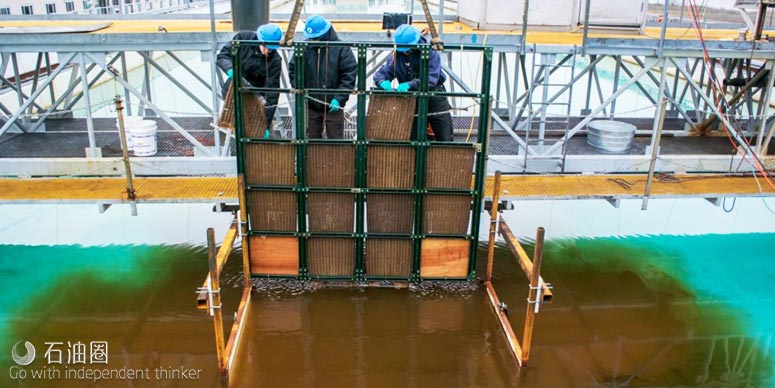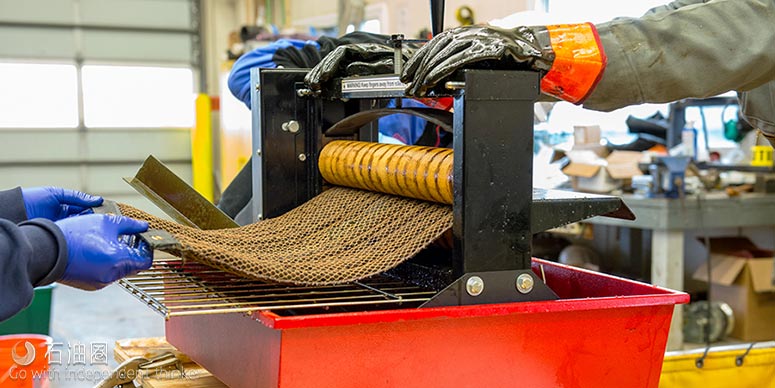Oil spills can result in billions of dollars in losses, and a considerable portion of the cost comes from the effort required to clean up these spills. Existing methods for cleanup are limited in their utility. None are able to capture oil suspended beneath the water surface, and most are nonreusable and unable to reclaim the oil that’s lost—factors that bog down response efforts and raise overall costs.
But a new sorbent invented by the U.S. Department of Energy’s Argonne National Laboratory overcomes these key challenges, offering a promising solution for making oil and diesel spill cleanups easier and more efficient, which could in turn mitigate overall costs and environmental impact.
The sorbent, named Oleo Sponge, is made up of strips of polymer foam coated with compounds engineered to be oleophilic, or oil-loving. When exposed to oil, Oleo Sponge adsorbs up to 90 times its weight in oil from throughout the water column, not just the surface. And once saturated the sponge can easily be wrung out and the oil recaptured, both ready for use once more.
Compared to traditional methods for oil containment and cleanup—namely skimming, in situ burning and the use of dispersants and disposable sorbents— the technology presents a number of distinct advantages based on its reusability, sorption performance and ability to extract oil in the water column.
Current methods
While able to recover oil, skimming (the process of removing oil from the water surface) cannot capture oil from the water column. Moreover, the technique can only be used under calm sea conditions and when oil slicks are sufficiently thick. Meanwhile, in situ burning, which is the controlled burning of oil at the site of a spill, fails to recover any of the oil spilled and emits toxic pollutants into the environment. Similarly, dispersants (chemicals that break down oil into small droplets for faster biodegradation) cannot recapture oil and are controversial due to their potential toxicity to human and marine life.
By comparison, Oleo Sponge may be a more economical and efficient option because the sponge can salvage the oil trapped below the water surface so that it can subsequently be reused, which can mitigate monetary losses. In addition, the sponge may be comparatively safer than burning because it does not release toxic products into the environment.
“Unlike traditional sorbents, no waste is created during oil spill cleanup using Oleo Sponge since both the oil and the sponge can be reused,” said co-inventor Seth Darling, a scientist with Argonne’s Center for Nanoscale Materials and a fellow of the University of Chicago’s Institute for Molecular Engineering.
The reusability of Oleo Sponge and its utility in capturing oil beneath the surface also sets it apart from other sorbents, most of which have yet to reach widespread commercial application.
Recyclability
Unlike Oleo Sponge, many existing sorbents are nonrecyclable, and the oil they absorb is nonrecoverable. And while most of those reported can sorb various oillike substances, they do so generally with comparably lower selectivity, capacity and sorption rates.
In tests Oleo Sponge surpassed industry-grade polypropylene, the only existing sorbent used at scale, in retaining its initial performance following repeated cycles of use; Oleo Sponge demonstrated a 97% retention rate on average during testing, while polypropylene maintained only a 14% retention rate on average. Meanwhile, other sorbents like silica aerogels, organoclays and carbonaceous materials remain in various stages of R&D.
To develop the sponge, Argonne researchers began with strips of polyurethane, a widely manufactured polymer foam found in everything from furniture cushions to home insulation. The foam has many tiny holes and crevices that provide a large surface area on which oil molecules can be captured.
To make the material capable of adsorbing oil, researchers first coated it with an inorganic metal oxide “primer” using a technique known as sequential infiltration synthesis, which was developed by Darling and Argonne chemist Jeff Elam. The technique allows scientists to grow inorganic materials within polymers, enabling them to build custom-designed materials with unique and complex properties.
The applied layer of oxides serves as a glue to bind oleophilic molecules, which are subsequently introduced. The oleophilic molecules function by binding the metal oxide on one end and binding oil molecules on the other. In a final step, the treated strips are assembled together in porous netting to form a sponge pad.
“Sequential infiltration synthesis as a technique was a result of fundamental research at Argonne, initially developed to explore new ways to create materials. The fact that it serves as the foundation of Oleo Sponge is a beautiful example of how basic research can translate into applications in unexpected and powerful ways,” Darling said.
Testing
Testing at Ohmsett, a facility that houses the largest North American seawater wave/tow tank, has verified Oleo Sponge’s effectiveness at recovering crude oil and diesel. At the site researchers exposed the sponge to clouds of diesel and crude oil that were interjected throughout the water column. Upon exposure the sponge successfully extracted both products from the entire column and retained performance following repeated use.
“We initially developed Oleo Sponge using 1-in. cubes on a lab benchtop. However, for the Ohmsett tests we had to manufacture 10,000 times the typical quantity and subject Oleo Sponge to real-world conditions cleaning up subsurface crude oil from saltwater in the winter,” said Elam, who co-invented the sponge. “We were extremely happy with the performance of Oleo Sponge; it showed virtually no degradation over one week of testing.”
Along with applications in oil spill cleanup, Oleo Sponge could also be applied in the cleanup of harbors and ports where diesel and oil accumulate in smaller quantities due to ship traffic.
The techniques used to manufacture the sponge also can be adapted to clean up other materials besides oil by attaching molecules that bind to these specific materials.
“We are exploring other applications for our technology, including the removal of heavy-metal ions such as lead and chromium as well as the cleanup of organic pollutants from water,” Elam said.
The team is actively looking to commercialize Oleo Sponge and has received significant interest in the technology.


 石油圈
石油圈
